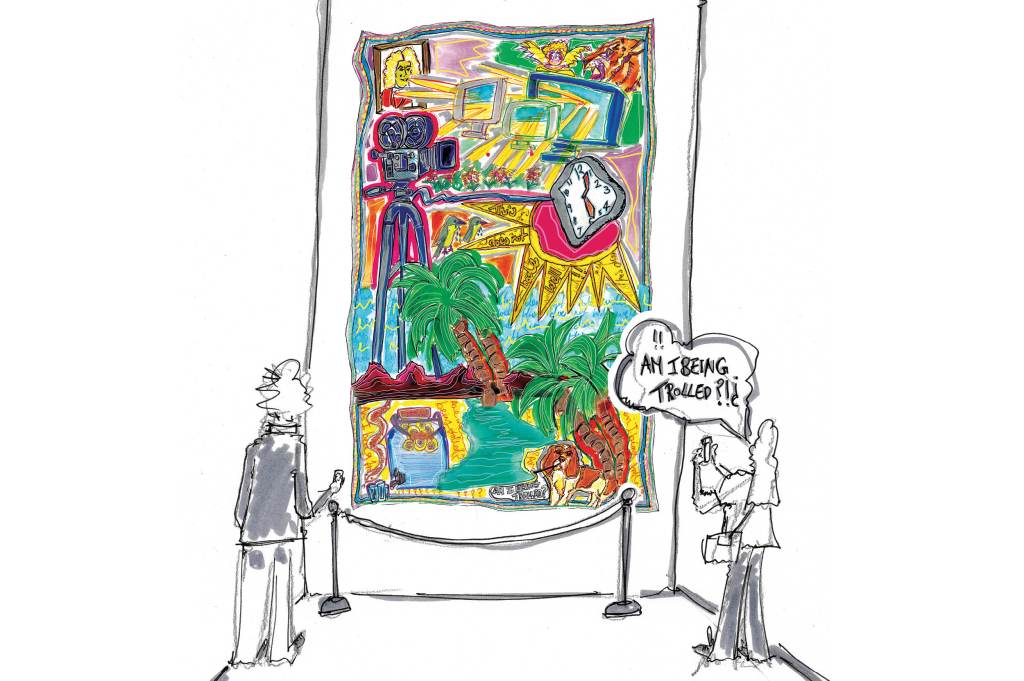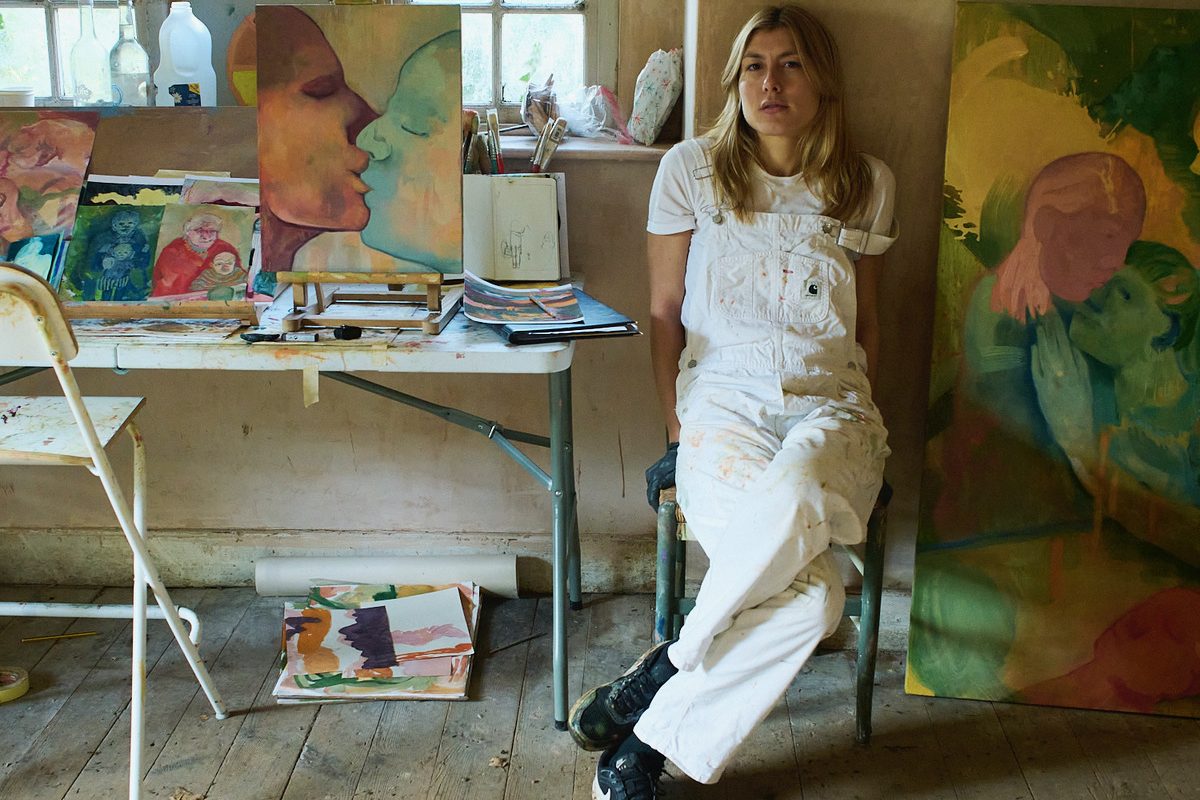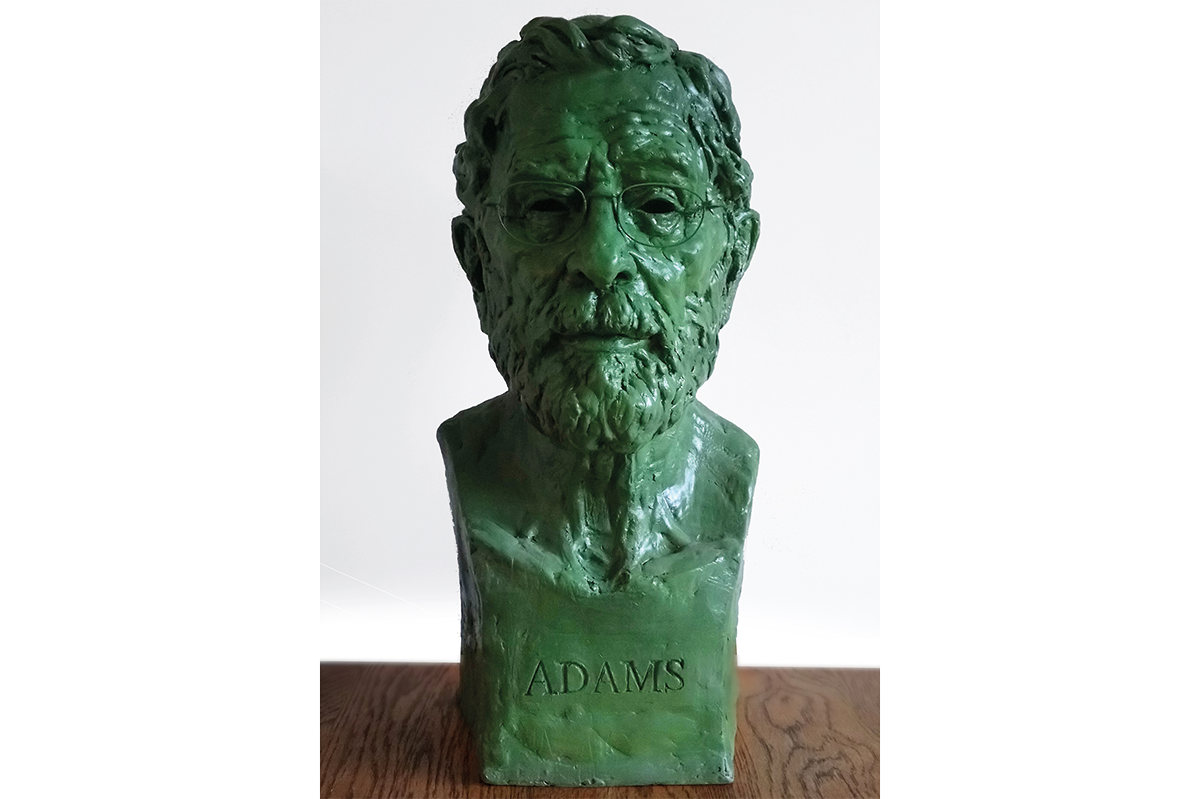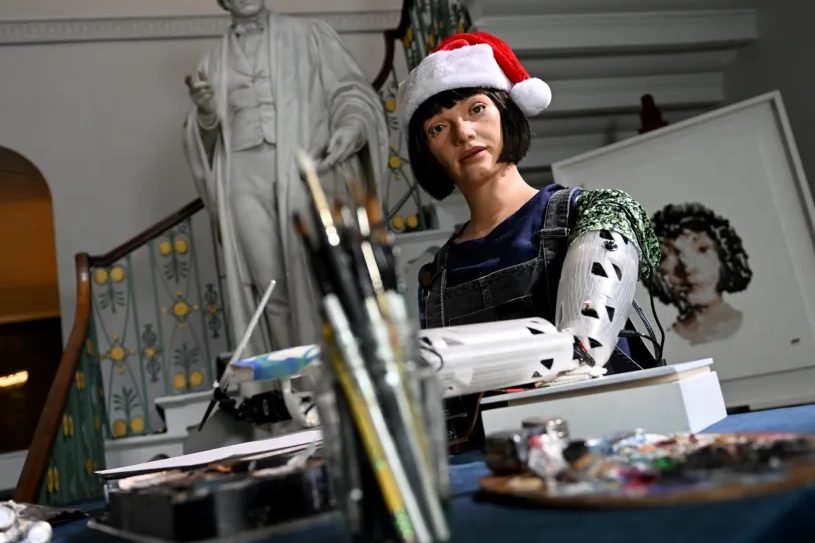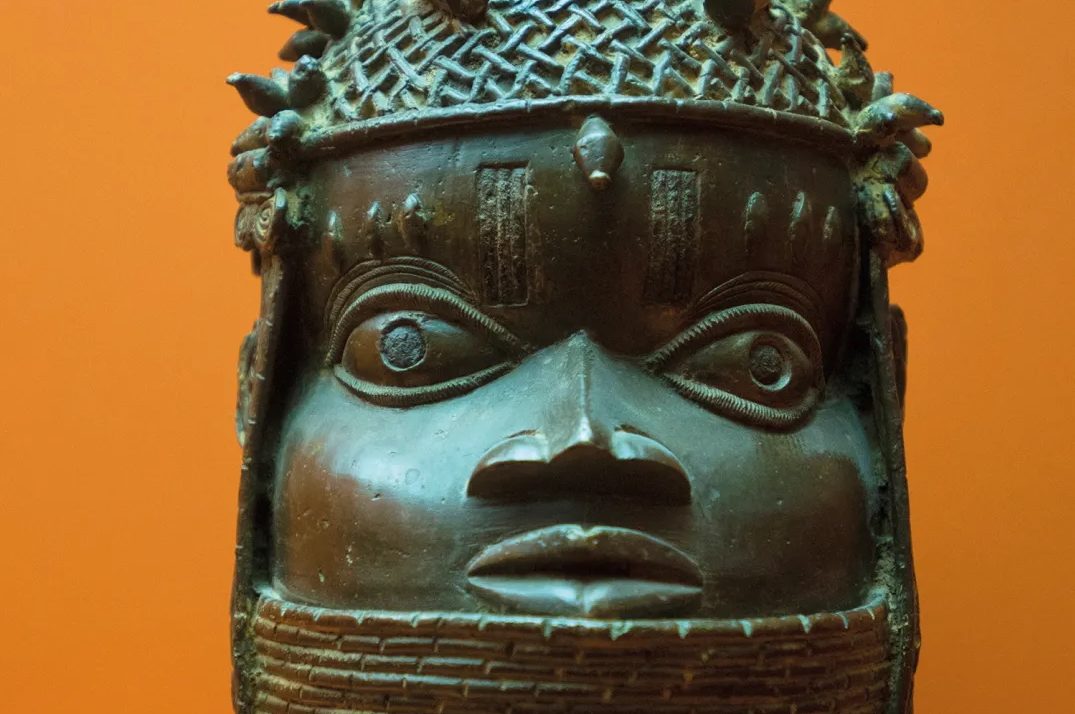“This is why I hate art.”
“Why, because this is pants?”
A friend and I were at a contemporary art show, standing before a mixed-media work featuring trite sayings, glittery flowers and a spaniel. A few days earlier I had suggested to her — once rather ominously described to me as an “art philistine” — that a visit to a few local galleries might provide an opportunity to acquire art for the new home that she and her fiancé recently purchased in the area. Somewhat to my surprise she agreed, so one evening we trundled along to some exhibition openings, to see what we might find.
Our first venue, housing three exhibition under one roof, was quite crowded when we arrived. The works ran the gamut from installations and video art to painting, drawing and collage. Given the variety on offer, I reasoned that there might be something here to interest a new collector.
Here is a helpful hint, gentle reader, based on some years of experience in such matters: should you spot a binder full of explanatory word salad at the entrance to an art exhibition, take it as a red flag. Or, to quote Lucille Bluth arriving at Klimpy’s restaurant and being told to sit anywhere she liked, “This does not bode well.”
In the first show a broken-but-functioning clock, whose mechanism was hooked up to video cameras that fed into various display monitors, ticked away while spotlights trained upon it periodically changed colors. “Oh, I like this,” my friend remarked, “this is fun.” I demurred.
As we watched the colors change to a split scheme of yellow and blue, I suggested, “Presumably this portion is a political statement about Ukraine.”
“Oh yes, of course,” she replied.
“Get with the times,” I chided, facetiously, “it’s in the news.”
“You’re so woke,” she lobbed back.
We discussed the illusory nature of time, during which conversation the irony that an art installation piece about time had robbed me of several minutes of my life was not lost upon me. “Is there a reason why these video screens are different sizes?” I eventually asked aloud, for want of anything else to say. “I don’t know. I also don’t want to ask.”
“I think that the artist is here in the gallery somewhere,” my friend said. “We could go find them.”
I declined.
Pressing on to the next gallery, we were confronted with rickety wooden scaffolding festooned with large, tumorous-looking lumps of purple… something or other. My friend thought that the blobby bits looked like rotting cauliflower or pig carcasses, while I was put in mind of discarded props from a Doctor Who set. The surrounding walls were hung with black and white drawings of ruined classical architecture.
“You’re going to have to try to explain this to me,” she said. After a long pause I admitted, “I can’t.” The accompanying exhibition text spoke of transforming decaying empires and shifting away from hierarchical relations.
At the entrance to the next show, I paused to look longingly at a lemonade dispenser set up on a refreshments table. “Sadly, it’s not spiked,” I remarked, wishing that I had an adult beverage to hand. “There are cookies, though,” observed my friend, more brightly. I scoffed down a cookie, and we began to study the exhibition, a strangely disturbing series of kitsch images executed in mixed media.
As I scrutinized the first work, a woman with rather extraordinary eyewear turned to face me, apropos of nothing, and authoritatively announced, “I always appreciate looking at line and space. And skill. High-level skill.”
“Mmm, do you?” I replied, and went back to looking at the art. The woman moved off. Most of the pieces in this exhibition were in intentionally bad taste, which made for more engaging conversation than what we had seen so far. “A crying bird,” I noted, as we examined one picture, “No wait — two crying birds!”
“And a snake?” inquired my friend, incredulously.
“Plus a little bit of sacrilege, because that always sells,” I said, pointing out evidence of anti-Catholicism. “Oh yah,” she nodded. “I see that.” “It’s always cheap to make fun of God,” said I.
Making our way round the room, we pointed out various details and techniques to each other. In one image, a mobile festooned with hooks and spiky implements was suspended over a child’s crib. In another, a cherub smiled blithely, oblivious to the approach of a snarling tiger.
We paused before an image of the Madonna and Child set upon on a stage. “Another bit of blasphemy,” I sighed. My friend peered more closely at the picture. “Is that a banana?” she asked. “Yup,” I replied tersely, before moving along.
Finishing our tour of the exhibitions, I asked my friend whether she had seen anything that she liked. She expressed a vague interest in the images of classical architectural fragments, but only because they were reasonably pleasant to look at.
“But that’s a huge first step for me,” she explained, “because normally I would say, ‘Well, this is all fucking bullshit.’ There has to be an attitude shift.”
“Is that because of a perception that anybody can make this sort of art,” I suggested, “and that there’s nothing to it?”
“You walk into a room like this,” she explained, “and you ask yourself, ‘Am I being trolled?’ People who sigh over this sort of stuff, do they really feel that? Or do they feel the need to do so because they’ve been told that they’re supposed to?”
As we moved to the next show, my friend explained that she was not brought up visiting museums and galleries, nor did she have the opportunity to study art history at school; she believed that this lack of exposure in her childhood affected her appreciation of art as an adult.
“When you thought about art, growing up,” I asked, “did you think that it was something that wasn’t for you?”
“Well, I’m now going to contradict myself entirely,” she replied, “when I tell you that I did art at school, up until I was eighteen.” She had studied drawing and painting, but that was strictly studio-based, and she found the constant practice required ultimately too taxing. “And that kind of took the love, or at least the appreciation, out of art for me for a while,” she admitted.
“I think that you have an appreciation for craft,” I suggested, “and when you don’t perceive that any craft has gone into making the art, you don’t understand why it would have a high value.”
She agreed. “I think if I look at something and say, ‘Well, I could have done that,’ that’s part of the issue for me. It may be why I’m always drawn to things like landscapes or portraits from the eighteenth or nineteenth centuries, for example, with immaculate details that I couldn’t do myself.”
At the next gallery, the space was smaller and less crowded; the art, however, was more interesting. After all the intentional ugliness we had just slogged through, it was like coming upon the proverbial oasis in the desert. Our mood changed, beginning with the very first painting in the show.
The large, beautifully executed picture, a contemporary Tonalist morning scene along the Chesapeake and Ohio Canal, was lush and evocative.
One imagined nineteenth-century mule barges disappearing into the mist and overhanging trees, or those famous Life magazine photographs of Jacqueline Kennedy strolling along its towpath shortly before her husband’s run for president. We were both dumbstruck with admiration.
“This. This is beautiful,” gushed my friend. “I would have this.”
“It’s absolutely gorgeous,” I stated categorically.
“Gorgeous,” she agreed, making a note of the artist’s name for further research.
We went on to look at a grouping of three paintings by three artists in different styles, and talked about how harmoniously they worked together despite their differences. Later, my friend admired the portrait of a woman dressed in a watery sort of gown, and we discussed both its Surrealist aspects and its rich palette of blues, purples and pinks. Near the end of the exhibition, we paused before a pair of paintings: a still life and a landscape by the same artist, both somewhat abstract in form, and drippy in execution.
“Does their sloppiness turn you off?” I asked.
She smiled. “A little bit. I think it’s difficult when something isn’t instantly recognizable, and it makes you work for what you think that it is.”
“It does make you work for it,” I agreed, enthusiastically. “You absolutely hit the nail on the head.”
“I didn’t even think this one was a landscape until you said the title,” she admitted. “But now I can kind of see it.”
Over dinner a short time later, I asked my friend whether what primarily appealed to her was art that had a story behind it.
“I’m not a very existential kind of person,” she explained, “I’m interested in reality, not feelings. The worst part of the world now is the ‘therapy culture’ that has come up in the last few years, where everybody has feelings, and they want to talk about them all the time. Truth is what’s important, more than feelings. To me, that’s life, and that’s what I like to see in art.”
“It seems to me that the real problem with the art world today,” I opined, “is that art is supposed to be for everyone…”
“But it doesn’t feel accessible,” she interjected.
“At all,” I agreed. “Despite the fact that all the art world does nowadays is talk about how accessible it is,” I continued. “And it’s not. It’s just more complicated and alienating.”
“I would completely agree,” she said. “It’s a lesson that I’ve had to learn as a journalist, to be more observant and look at the world around you to see and describe clearly what is really going on. Now when I go into a room, I look at things like the art on the walls or the books on the shelves, because it helps tell me the story.”
“One difference,” I suggested, “is that we have lots of time with language to develop and tell a story. And art doesn’t. Because if you don’t get it fairly quickly, and you’ve got to go read a long description in order to understand what it is…”
“Then you’ve lost it,” she concluded; I nodded vigorously in agreement.
“And I thought that what was interesting about sharing this experience with you tonight,” I remarked, “was that, for someone who doesn’t go to art exhibitions, you dove right in and tried to understand it, even when the art was incomprehensible.”
“Certainly in the first gallery we went to, there was nothing that I would particularly have sought out to hang on my walls,” she admitted. “But again, it’s like we were saying before with respect to ‘therapy culture,’ you go in there, and instead of thinking, ‘Well this is all bad, and the rest of my day and my mood are going to be bad, and therefore this conversation won’t go any further,’ to be an adult is to say to yourself, ‘Well we’re here now, and we’re going to have an interesting discussion that stems off of each other and bounces back and forth.’ That means that we can debate, and I can say to you, ‘I think this is absolute horseshit’, and you can say, ‘Well, I see this or that,’ and we can listen to each other.”
“So now you’ve had the experience of visiting some commercial art galleries,” I observed. “Is that something that you would do again?”
She thought for a moment. “Yeah, I would. But I think the experience was kind of sterile. What I’d really love to do is go to a huge antiques fair or estate sale, and sift through the paintings for sale there. I just want to find an individual piece I like and say, ‘Oh that’s great. I don’t want to leave without that.’”
“I think that’s the best mindset,” I opined, “not to acquire things simply because some supposed authority told you to do so.”
“Exactly, it’s just fun, and that’s what I want our future home to be,” she explained. “Maybe we’ll have something like a 1960s conversation pit in the living room, surrounded by eighteenth-century portraits. I don’t know. But I also don’t have any preconceived ideas, I just like what I like.”
And as anyone who has not drunk too deeply from the art establishment Kool-Aid will tell you, that’s the best art collecting advice there is.
This article was originally published in The Spectator’s October 2023 World edition.



